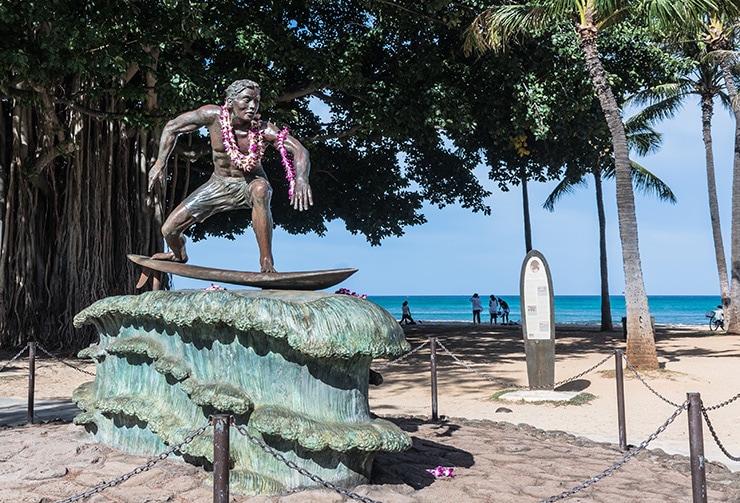It might be hard to believe that one of the most popular aquatic sports is also one that doesn’t have a long track record behind it. While SUP history is rather short, the practice of paddle boarding itself is one that has long roots tracing all the way back to ancient times.
This article will take a look at the interesting history of paddle boarding. We’ll take a look at how some of the world’s most popular and talented aquatic athletes have helped shape modern day stand up paddle boarding.
Plus, we’ll also look at how paddle boarding has not only been accepted throughout the world but thrived as a relaxing and low stress level sport.
Who Invented Paddle Boarding?
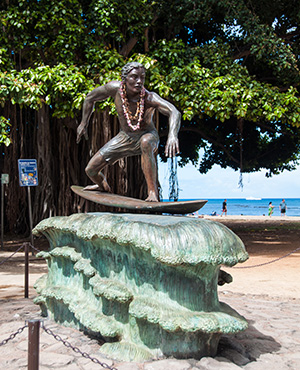
Modern paddleboarding dates back to the 1940s in none other than Waikiki Beach, Hawaii. Brothers Leroy and Bobby Ah Choy and their father John Ah Choy are credited with helping set the foundation for what modern stand up paddle boarding is today, an undeniable global phenomenon.
While paddling on his canoe along Waikiki Beach, John Ah Choy would regularly stand up to paddle out into the waves. Issues with his knees made it difficult for him to sit for long stretches of time. Standing on the canoe allowed him to stretch out while having a better vantage point of the surfing students he was working with.
John Ah Choy’s two sons adopted the habit of standing and were often seen on the shores of Waikiki standing up on their boards. Over time, this style of standing up while on the water became such a common practice that it was dubbed “Beach Boy Surfing.” It wasn’t long before other Beach Boys dominated the waterways too.
While the Ah Choy beach boys unapologetically adopted this unique paddling style, legendary surfer Duke Kahanamoku dubbed “The King of Waikiki Beach” also began to incorporate standing to paddle into his own surf lessons. Just like the Ah Choy brothers, standing offered King Duke a better line of vision of his students and upcoming swells.
Modern day surfing gave rise to modern day paddle boarding, and the Ah Choy brothers and Kahanamoku are regularly credited as being the inventors of SUP as we know it. While they might not have known it at the time, their contributions to the sport laid the framework for what stand-up paddleboarding would ultimately become.
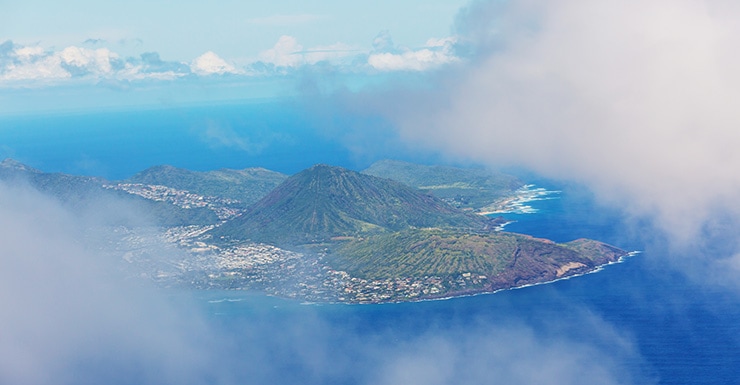
Paddle Boarding Dates Back to Ancient Times
Before stand up paddle boarding transformed into what it is today, the practice had been well recorded throughout history, dating back to ancient times. Flip through any history book and you’ll find records of paddling while standing up being implemented in all corners of the globe.
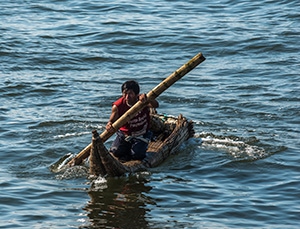
As far back as 3000 B.C., fishermen in Peru are known to have used Caballitos de Totora, a floating platform made out of reeds propelled by bamboo shafts that acted as paddles. These Peruvian fishermen would go out onto the water and stand on the platform as they fished.
In the Middle East sometime during the 8th and 13th centuries, Arabian fishermen used a Hasake to venture into the water as well. This watercraft took on the shape of today’s paddle boards and was used as a way to catch fish.
Even in Europe, gondola drivers were known and are still known for paddling through the canals as they transported passengers and goods.
Some of the most concrete evidence of paddle boarding is found throughout Asia as well. In 1778, British explorer Captain James Cook encountered Polynesian paddle boarders for the first time after he discovered the Hawaiian Islands.
He noted that Polynesians would use flat boards on which they stood and trekked the waters, a practice which grew to be known as surfing. Typically, the chief not only had the best board, made out of the best quality wood, but was also the most experienced surfer.
While stand up paddle boring itself was not yet a universal sport, the skills associated with stand up paddle boarding can certainly be traced back to ancient times all through the globe.
Paddle Surfing in Hawaii Laid the Foundation for SUP
The unique community of surfers throughout Hawaii has largely helped lay the groundwork for what modern stand up paddle boarding is today. Because of Hawaii’s rich surfer community and love of aquatic sports, much of modern day paddle boring roots can be traced back here.
While modern day stand up paddle boarding cannot be credited to any one specific person, but instead a collective group of surfers, some surfers stand out more than others.
Hawaii’s celebrated and beloved Duke Kahanamoku helped evolve surfing into paddle boarding. But not without the help of the Ah Choy brothers and their father.
Many consider John Ah Choy to be the pivotal force that helped inspire stand up paddle boarding. His need to stand up while paddling in order to give himself a break and stretch out his legs is regarded as the first stone in the foundation of modern day stand up paddle boarding.
Standing up while on the canoe was also an efficient way to take pictures of surfers, keep an eye on the safety of surfers, and monitor swells. Standing while paddling was also an effective way to keep essential items dry while out on the water.
In fact, there are many reports that Bobby Ah Choy was often seen paddling around with a pack of smokes strapped on his arm and his camera slung across his shoulder. By staying upright, Ah Choy could keep his gear dry when he went out.
Paddleboarding was also born out of a somewhat need to give surfing a facelift. Greats including Laird Hamilton and Duke Kahanamoku are often referenced for their influence in helping push surfing to greater audiences, ages, and abilities.
Because of the expansive surfing community throughout Hawaii, there were many other Aquatic athletes who helped shape stand up paddle boarding as we know it.
How Did Modern Paddle Boarding Get So Popular?
As early stages of modern stand up paddle boarding began to brew on the shores of Hawaii, it wouldn’t be long until the sport exploded into a global phenomenon.
While there are undoubtedly many people who helped shape modern stand up paddle boarding into what it is today, some stand out more than others in this effort.
Surfer Duke Kahanamoku Is the Modern Surfing Godfather
Before stand up paddling emerged, the essential groundwork needed to be laid. That’s where surfing comes in.
Iconic surfer Duke Kahanamoku has often been dubbed “The Godfather of Surfing.” He helped transform how the globe saw surfing as a recreational sport. Having influenced the sport in such an impactful manner, it became easy for surfing enthusiasts to make that transition to stand up paddle boarding later on in the 2000s.
King Duke as he was dubbed was not only a Hawaii citizen, and the sheriff of Honolulu, but he was a renowned Olympic swimmer. Fans took notice when he would stand on his board to navigate the water, and get an overall better view of surfers.
As a surfing instructor, he took cues from the Ah Choy brothers, normalizing standing as a way to navigate the water.
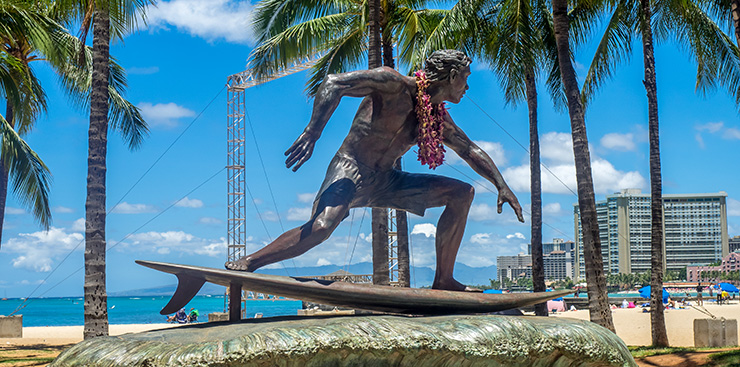
Laird Hamilton Paved the Way for Competitive SUP
Iconic big wave surfer Laird Hamilton helped give surfing a fresh facelift in 2002. Hamilton was photographed navigating Malibu, California waters while standing on a board with an American flag attached to his paddle.
This iconic photograph circulated throughout the leading surf magazines and was one of the earliest images of modern day stand up paddle boarding.
Hamilton’s influence on stand-up paddle boarding helped push it into a competitive sport as well. In 2004, stand up paddle boarding was included in the Buffalo Big Board Contest as a category of its own.
Rick Thomas Took Paddle Boarding to America’s West Coast
As stand up paddle boarding began to gain momentum in the early 2000s, Rick Thomas helped speed up the inevitable. Thomas had a custom 11-foot paddle board built, and when he brought that board to California’s shores, stand up paddle boarding entered a new era.
Thomas showed the world how paddle surfing no longer required waves. With a stand up paddle board like Thomas’, anyone could venture out onto lakes and rivers without ever needing a wave to enjoy the water.
Not only did this give aquatic sports lovers a new way to enjoy their time out, Thomas’ introduction of stand up paddleboarding to Californian shores gave surfing a much needed breath of fresh air.
Thomas’ original paddle board size and style also helped influence the earlier models of stand up paddle boarding.
Modern Paddle Boards Dominate Waterways in the 2000s
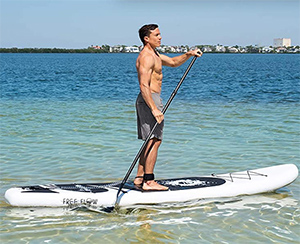
In the early 2000s, stand up paddle boarding began to slowly capture the hearts of surfers and others on the water. However, through the efforts of some of surfing’s most legendary names, stand up paddle boarding began to catch on.
One of the allures of stand up paddle boarding was that you didn’t need waves in order to surf. In fact, it wasn’t even surfing anymore. It was a class of water recreation all on its own.
This relaxed method of surfing enabled paddlers to venture out nearly anywhere there was a body of water. Leisurely stand up paddle boarding on lakes and rivers began to dominate the west coast and not long after, the rest of the U.S. and the globe.
When paddlers realized they could venture anywhere, stand up paddle boarding began to pop up along the shores of some of the globe’s most beautiful beaches. Costa Rica, Mexico, and other South American countries slowly became hubs where paddle board enthusiasts could flock to.
Today, you’ll find hundreds of paddle boarding communities scattered across the world’s most beautiful shores. Coastal communities throughout Europe, Asia, and South America have built economies that revolve solely around paddle boarding.
Well into the early 2000’s, stand up paddle boarding began to carve a space for itself in the world of aquatic recr2000sational sports. Today, paddle boarding is a booming industry with a number of companies, products, and small scale businesses operating around the sport.
Paddle Board Yoga
Stand up paddle boarding has also given rise to recreational activities unique to the sport itself. Aside from just standing on a board and paddling along, paddlers can enjoy some relaxing meditation through paddleboard yoga.
Paddle board yoga became and still is one of the most popular activities out on the water. Today, you’ll find a number of businesses and courses dedicated to getting out on the water and connecting your inner self with the outdoors.
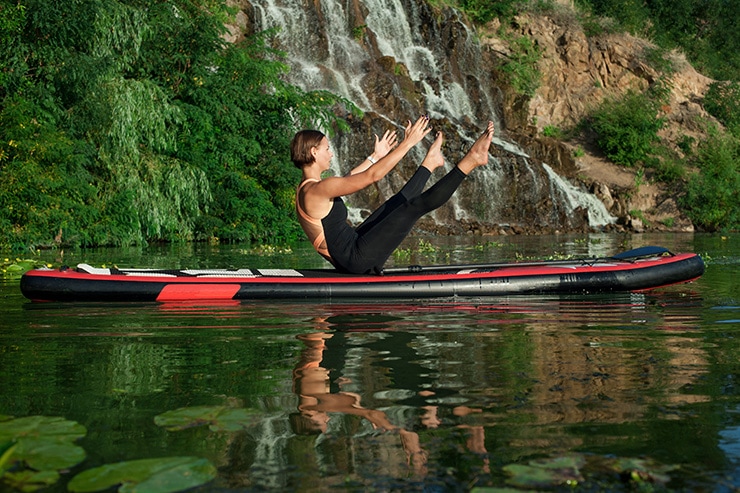
SUP Fishing
Fishermen have also taken notice of stand up paddle boarding and have created a niche of their own as well. Popular paddleboarding brands like a Bote recognize the need for a stand up paddle board designed specifically for stand up paddle board fishing.
Much like the Ah Choy brothers realized, paddle board fishing allows you to stretch out on the water, and get a better vantage point. For many fishermen, these are two elements that have helped make SUP fishing a popular activity.
Conclusion
Stand up paddle boarding as we know it is the result of a number of talented surfers who love the sport enough to see it grow and evolve. While the earlier forms of stand up paddle boarding were rooted in practicality, its modern roots were about enjoying surfing in a relaxed setting.
Stand up paddle boarding incorporates many of the same elements of traditional surfing, while also offering other aspects surfing doesn’t. Being able to relax on your board, enjoy the water without waves, and in many ways be more versatile have allowed SUP surfing to be adopted into surf culture seamlessly.
The ease of stand-up paddle boarding has made this sport attractive to audiences of all ages, and ability levels. Unlike surfing which can be intimidating to some, using sup boards has proven to be an easier way to get out on the water.
For these reasons, and many more, modern SUP is here to stay. While the sport may continue to evolve, it’s undoubtedly made a name for itself and isn’t going anywhere anytime soon.

